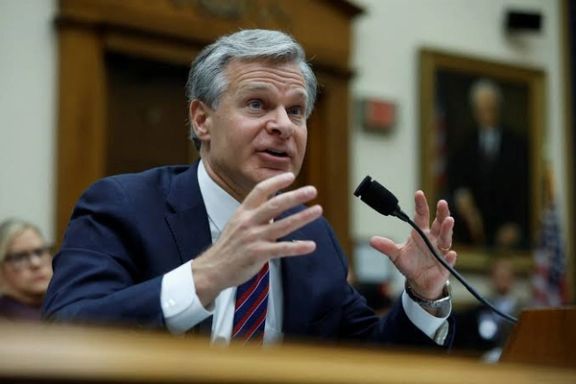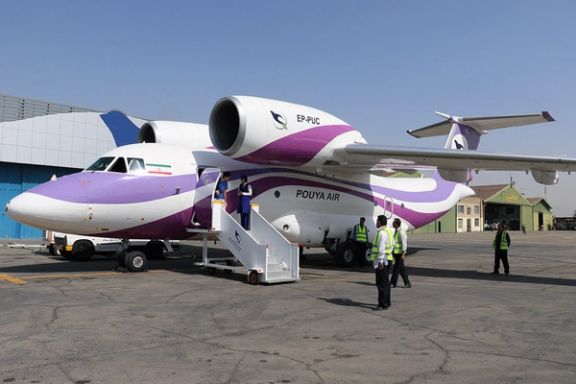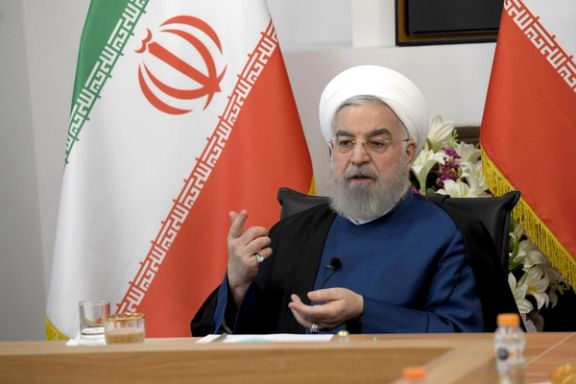FBI Director Warns About Audacity Of Iran Plots

FBI Director Christopher Wray has raised concerns about the threat of Iranian plots, labeling them as distinct and palpable.

FBI Director Christopher Wray has raised concerns about the threat of Iranian plots, labeling them as distinct and palpable.
Director Wray made the remarks during a presentation addressing prominent foreign and domestic threats to the United States at the International Spy Museum in Washington DC, on Thursday.
As reported by AP, Director Wray referenced a significant Iranian plot that unfolded in 2021, involving a foiled attempt to assassinate former National Security Adviser John Bolton. The motive behind this plot was purportedly retaliation for the US drone strike that had targeted Iranian commander Qasem Soleimani.
Additionally, Wray highlighted a cyber-attack on Boston's Children's Hospital orchestrated by Tehran in 2022 and Iran's covert influence campaign during the 2020 US presidential election.
He emphasized, "That's all on top of constantly trying to evade international sanctions and being the world's leading state sponsor of terrorism. So if that's not enough to convince people that this is a serious threat, I don't know what is."
On the domestic front, Wray underscored the FBI's elevation of racially-motivated violent extremism to a national threat priority in 2019, aligning it with the threat level posed by ISIS. More recently, the FBI has intensified its focus on anti-government and anti-authority violent extremism, spanning from militia groups to anarchist violent extremists.

The upcoming week will pose some serious questions to the Biden Administration as moves to examine its failings in dealing with one of the most malign regimes continue.
The US House of Representatives is also expected to put the final stamp on the bipartisan Mahsa Amini Human Rights and Security Accountability (MAHSA) Act after it was submitted in June, seeking more sanctions on Iran’s leadership.
Named after Kurdish-Iranian Mahsa Amini, whose death in morality police custody in September 2022 led to the boldest revolt against the clerical regime since its establishment in 1979, the Act won unanimous approval at the US House of Representatives Foreign Affairs Committee in April, before Senators Marco Rubio (R-FL) and Alex Padilla (D-CA) introduced the bipartisan legislation to the Senate in June.
Essentially similar and a companion to the one passed in the House committee, the MAHSA Act will potentially commit the administration to report to Congress within 90 days of the date of the enactment and periodically thereafter, making determinations about whether certain existing sanctions apply to specific people and impose the applicable sanctions.

The bipartisan bicameral move requires the executive branch to impose applicable sanctions on Ali Khamenei, his office and his appointees, as well as President Ebrahim Raisi and his cabinet officials, foundations and other entities affiliated with the Supreme Leader under section 105(c) of the Comprehensive Iran Sanctions, Accountability, and Divestment Act of 2010, section 7031 (c) of the Department of State, Foreign Operations, and Related Programs Appropriations Act, 2021, and Executive Orders 13876, 13553, 13224, and 13818.
“The Supreme Leader is an institution of the Islamic Republic of Iran … that holds ultimate authority over Iran’s judiciary and security apparatus, including the Ministry of Intelligence and Security, law enforcement forces under the Interior Ministry, the Islamic Revolutionary Guard Corps (IRGC), and the Basij, a nationwide volunteer paramilitary group, subordinate to the IRGC, all of which have engaged in human rights abuses in Iran,” reads a paragraph of the MAHSA Act.
It follows moves earlier this year when Democratic and Republican leaders on the House Foreign Affairs Committee introduced a bill to target Iran’s production and exports of missiles and drones, with an eye toward the soon-to-expire United Nations restrictions on Iran’s missile program.
The Fight and Combat Rampant Iranian Missile Exports (Fight CRIME) Act levies additional sanctions on Iran and asks the administration to outline a strategy to prevent the UN restrictions from expiring.
Demands for harsher actions against the regime continue to blight the administration which has been dogged by allegations of its being too soft as it tightropes between negotiating to revive the JCPOA nuclear deal while Iran continues to forge ahead with acts against the US in the likes of Syria and Iraq. Since the Biden administration came to power, over 80 attacks have been made on US facilities and personnel overseas by Iran, with just five retaliatory attacks from the US.
On top of this, is the controversy surrounding suspended US envoy to Iran, Robert Malley, who is under investigation for alleged leaking of confidential information to Iran.

Just this week, FBI Director Christopher Wray highlighted what the FBI sees as some of the leading foreign and domestic threats to the United States in an hour long program at Washington, D.C.'s International Spy Museum.
Among those mentioned was the Iranian plot to assassinate former National Security Adviser John Bolton in 2021 in retaliation for the US drone strike that killed Iranian commander Qasem Soleimani. Bolton is one of a list of targets from the Trump administration with threats to their life from the regime. Wray also brought up a cyber attack by Tehran on Boston's Children's Hospital last year and its covert influence campaign on the 2020 US presidential election.
"That's all on top of constantly trying to evade international sanctions and being the world's leading state sponsor of terrorism," Wray said, "So if that's not enough to convince people that this is a serious threat, I don't know what is."
Former US representative to Iran, Elliott Abrams, this week called on a total travel ban for Iranian citizens going to Iran for the high risk of kidnapping, following the $6 billion deal exchanging five US citizens for freeing up frozen funds in South Korea. It is an issue which has created huge divisions in Washington and allegations that the Biden administration has opened the door for yet further hostage diplomacy.
Next Wednesday, the House Committee on Oversight and Accountability is holding a hearing on Iran titled "A Dangerous Strategy: Examining the Biden Administration’s Failures on Iran”.
Gabriel Noronha, former US representative to Iran said it was a much needed step. “Next week's hearing on Iran is only the second during the Biden Administration and the first in 15 months. This despite Iran's nuclear program advancing, ~10 Americans living under assassination threat, failed negotiations, and the US envoy for Iran under security investigation.”
He said while Congress' attention is justly focused on China as the paramount threat to the United States, on Russia given its war against Ukraine, and on the withdrawal from Afghanistan, “it has taken its eye off the ball when it comes to Iran”, which he claims is now the US’ “number two threat”.
Jason Brodsky, Policy Director from United Against A Nuclear Iran welcomed the initiatives saying, "we're making progress. After the House had not held even one Iran-focused hearing since 2020, there are now two in one week next week".

UPDATE - Flightradar24 later issued this notice - Following up on this, it was data uploaded by a software sharer. We’ve disabled the source and continue to implement additional measures to prevent any inauthentic data.
---------------------------------------------------------------------------------------------------------------------------------------------------------------
An Iranian transport aircraft recently departed from the closed Simferopol airport in Crimea, raising questions about the nature of Iranian involvement in the Russian invasion of Ukraine.
The aircraft, the IL-76TD owned by Pouya Air, took off from Simferopol at 17:09 local time, having arrived in Crimea just two hours prior. Simferopol airport has been closed for civilian air travel since the commencement of the full-scale Russian invasion of Ukraine. The development was reported by Flightradar24, a prominent air travel tracking service.
Pouya Airlines has dismissed reports about the flight in the Crimean Peninsula to assist Russian forces as "pure fabrication." The airline stated that the aircraft had been parked at Mehrabad Airport for the past 48 hours.
Ukrainian military sources have previously alleged that Russian forces stationed in Crimea have been utilizing the Chauda training ground to launch Iranian-made Shahed-136/131 drones into Ukrainian territory. However, there is no confirmed information regarding the presence of Iranian personnel assisting Russian military operations during these drone launches.
It is noteworthy that Russia began employing Iranian-produced Shahed drones for attacks deep within Ukrainian territory the previous year. These so-called kamikaze unmanned drones possess the capability to operate without the need for a conventional runway, detonating upon impact.
Iran has publicly acknowledged sending drones to Russia but has maintained that these deliveries occurred prior to Russia's invasion of Ukraine in February 2022. Moscow, on the other hand, has consistently denied employing Iranian drones in Ukrainian conflicts. Nonetheless, Ukraine has repeatedly reported the consistent bombardment from Iranian drones in Russian hands.

The cost of living in Iran has reached staggering levels, with the year-on-year inflation rate for households across the country soaring to 39.8 percent in August.
According to a report by Iran’s Labor News Agency, when considering minimum living standards, the cost of living has surged to 194 million rials, equivalent to approximately $400 per month. However, when factoring in housing expenses, particularly in Tehran, the cost of living exceeds a daunting 230 million rials, approximately $460 monthly.
Major industrial cities such as Mashhad, Esfahan, and Tabriz also witness high costs of living ranging from 200 to 220 million rials per month.
Currently the minimum wage in Iran is about $150 a month and the average income of people is between $150 to $250. Key workers remain at the bottom of the pay scale. Iran's Teachers' Association recently said that a third of the country's educators earn less than $200 a month, meaning many are fleeing for work abroad.
One of the primary contributors to Iran's economic turmoil is the drastic depreciation of its currency, the rial. Just over a year ago, the rial was trading at approximately 300,000 to the US dollar. However, in early May, it plummeted to as low as 550,000 rials to the dollar, and currently hovers around 490,000 rials to the dollar. This catastrophic devaluation of the rial directly reflects the nation's inflationary crisis.
Iran heavily relies on imports for essentials like food, animal feed, medicines, raw materials, and finished goods. As the local currency continues to lose value, the cost of imports escalates, ultimately leading to higher prices for consumers. This, in turn, places an additional burden on Iranian households already grappling with soaring living costs.

A video of UK’s Ambassador to Tehran Simon Shercliff talking about Iran has sparked a social media buzz with Iranians wishing they were enjoying the country as he does.
The British Embassy in Iran stirred social media discussions earlier this week when it shared a video interview with the British envoy in which he engaged in a casual and friendly conversation in Persian. During short questions and answers published as an Instagram post, Shercliff expressed his views on various cultural, social, historical, and tourism-related aspects of Iran.
In addition to expressing his fondness for Iranian people and culture, he called Shiraz “the best city” he visited and Rasht a city that bears the most resemblance to British cities. Mimicking the accent of people in the central city of Esfahan (Isfahan), he said that he liked best this accent of Persian. He also acknowledged his appreciation for Iranian cuisine and claimed that he can make a good Iranian kabab.
He named the mythological figure Kaveh the Blacksmith as his favorite, a statement that was construed by several pro-regime users as signaling “a code.” Kaveh is a 5000-year-old figure in Iranian mythology who led an uprising against ruthless ruler Zahak, a metaphor for Supreme Leader Ali Khamenei in a lot of slogans chanted by people during last year’s uprising against the regime.
A large number of Iranian users commented on the British Embassy's Instagram post, with some users saying that Iranians never forget UK policies and actions against Iran in the 20th century and some wishing for the Iranian people to enjoy Iran just as much as Shercliff does.
Some users asked for Shercliff's assistance in facilitating the visa application process, especially for Iranian students aspiring to study in the UK. This comes at a time when many Iranian citizens face significant challenges in obtaining visas from various embassies, notably the British Embassy, amid a surge in immigration from Iran.
A lot of users pointed out Ambassador Shercliff's fluency in Persian, contrasting it with the often-limited English proficiency of Iranian diplomats. Others criticized the video's release, viewing it as part of what they referred to as the UK's "hidden and old policies" of social influence in other countries.
Praising the Shercliff's fluency in Persian, moderate Iranian news website Rouydad 24 said that “over 90 percent of Iranian diplomats in other countries were reported to lack proficiency in the local language.” "On the contrary, you can see the British ambassador showing off a commendable command of even Iranian dialects, as evidenced in this video with his proficiency in Esfahani Persian."
A pro-regime website in Tehran said that the ambassador’s profound understanding and precise mastery of Persian language, culture and customs raises questions about his background and training, claiming that such a level of cultural acumen can only be achieved if he received training from the British foreign intelligence service, the MI6. The website also mentioned Alireza Akbari, a former Iranian defense ministry official and an Iranian-British citizen, who was accused of spying for MI6 and executed.
London’s ambassador in Tehran has appeared regularly in news pieces in Iranian media as he has been summoned several times during the past year to the Islamic Republic’s foreign ministry over remarks either by himself or by other British officials about the regime’s crackdown on protesters. The latest incident was in August when he was summoned after he published comments calling for the release of jailed journalists.
In January, he published pictures, which he took together with his French and German colleagues Nicolas Roche and Hans-Udo Muzel, showing their embassies where Iranian regime elements had vandalized with anti-West slogans. A few days after a group of Iranian citizens voluntarily helped paint the walls, Tehran municipality headed by a hardliner mayor, installed banners near the embassy in the downtown bearing the sentence, “Shame cannot be erased with paint.”
In 2021, Russia's ambassador to Iran Levan Dzhagaryan (Jagarian) tweeted a photo of himself and Shercliffat the Russian embassy in the chairs made famous by a celebrated portrait of World War Two leaders, saying it was taken from the "historic steps of the 1943 Tehran conference." The 1943 conference was attended by former US president Franklin D. Roosevelt, Former UK Prime Minister Winston Churchill, and former Soviet dictator Joseph Stalin.


Iran’s former President Hassan Rouhani has criticized the harsh treatment of the elite, alleging that some officials are pleased that they are leaving the country.
“I went to the United States in 2014 where I delivered a speech to [expat] Iranians. All of them longed to return home,” he said in a speech to his former aides and ministers on August 28 a short video of which was only published on Tuesday.
Rouhani added that an expatriate, apparently with high qualifications, who returned after this meeting was arrested at the airport, presumably by security forces taking their orders from places other than his government.
“They shut the door. Sadly, some people are happy that our talented youth are leaving. They say, 'Let them go so that others who support the hardline government can take their place,'" he said.
“We would not be facing this level of emigration if effective action had been taken by the government,” warned Shahriyar Heidari, an independent lawmaker who is deputy chairman of the parliament’s National Security and Foreign Policy Committee of the parliament. He also expressed concern about serious damage to the country’s academic foundations. “Most of the emigrants are gifted and expert individuals,” he added.

Pundits have repeatedly warned about the surge in emigration of academics, entrepreneurs, and professionals, particularly healthcare staff, and the younger elite since hardline President Ebrahim Raisi, took office two years ago.
There is no transparent data on emigration of Iranian elite and professionals, but some lawmakers occasionally provide fragmentary information about the scope of the problem.
Among those who have lost hope in the country’s prospects, particularly the younger generation from all walks of life, emigration appears to be the only option for a better life. A recent poll by the US-based Statis Consulting found that almost half of Iranian youth want to leave the country amid pessimism about their future.
“All around me there are people who are emigrating, essentially escaping, those who never wished or liked to go. I wish you [the Islamic Republic] were gone and all of these people stayed,” an anonymous person wrote said on social media.
Bahram Salavati, the head of Iran Migration Observatory (IMO), warned about "mass migration" and loss of human capital due to what he dubbed "Venezuelization of the Iranian economy" resulting from low “economic stability” and inflation in January 2021. "The desire to migrate once prevalent among the educated and the elite is now rapidly spreading among various social classes, particularly the low-income groups.”
The IMO, a research institute founded during Rouhani's second term as president at Sharif University of Technology, monitors data and produces analyses on emigration, particularly for policymakers. The IMO published the first edition of Iran Migration Outlook, which includes data on Iranian emigrants worldwide, international students, and asylum-related emigrants.
On August 2, while expressing his frustration over the lack of support for their efforts to mitigate the brain drain phenomenon, Salavati said that the observatory's funding had stopped, and they had been ordered to vacate their offices.
An IMO survey in 2022 found that economic and social instability, institutionalized corruption, and the regime's governance methods were responsible for the very high desire to emigrate among medical students, professors, and other healthcare professionals, with the UAE being their top destination.
Countries such as the United States, Canada, Germany, Turkey, Oman, and the United Kingdom are other favorite destinations for Iranians leaving their homeland behind in search of a better life and improved opportunities.
In July 2021, Salavati had told the Hamshahri newspaper that the closure of the gap between a desire to leave and a decision to leave meant "a drop in hope as well as economic and social participation in Iran," as other countries offered various educational, professional, investment, or social attractions.






